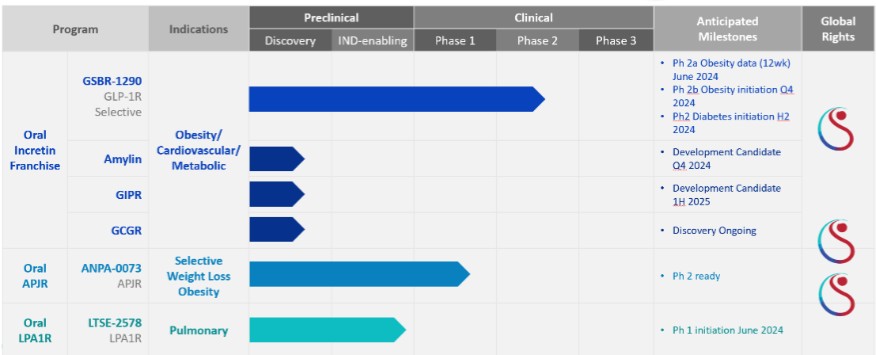and sell products or are pursuing the development of product candidates for the treatment of the indications that we are pursuing. Potential competitors also include academic institutions, government agencies and other public and private research organizations that conduct research, seek patent protection and establish collaborative arrangements for research, development, manufacturing and commercialization.
We are aware of GLP-1R small molecules in development by Pfizer, Eli Lilly, Qilu Regor Therapeutics Inc., AstraZeneca/Eccogene and Carmot Therapeutics, Inc. (which was acquired by Roche Group in January 2024). There are currently approved GLP-1R peptides for the treatment of diabetes and obesity marketed by Novo Nordisk, Eli Lilly, AstraZeneca, and Sanofi. We are also aware of other GLP-1R plus dual/tri incretin targeting peptides in development by Eli Lilly, Jiangsu Hansoh Pharmaceutical Group Co., Ltd., Boehringer Ingelheim, Altimmune, Inc., Carmot Therapeutics, Inc., Sciwind Biosciences Co., Ltd., Novo Nordisk, Viking Therapeutics, Amgen, Zealand Pharma, D&D Pharmatech, GMAX Biopharma and Jiangsu Hengrui. Additionally, we are aware of APJR targeted product candidates in development for COVID-19 acute respiratory distress syndrome by CohBar, Inc.; IPF, systemic sclerosis interstitial lung disease, and kidney nephrotic syndrome by Apie Therapeutics; and muscle atrophy by BioAge Labs, Inc. Both Amgen and BMS have APJR targeted product candidates for heart failure. Furthermore, we are aware of LPA1R targeted product candidates in development for IPF by BMS, Horizon Therapeutics plc, which was recently acquired by Amgen, and DJS Antibodies Ltd; myelin restoration and neuroinflammation by Pipeline Therapeutics.
Many of our competitors, either alone or with their collaborators, have significantly greater financial, technical, manufacturing, marketing, sales and supply resources or experience than we do. If we successfully obtain approval for any product candidate, we will face competition based on many different factors, including the safety and effectiveness of our products, the timing and scope of marketing approvals for these products, the availability and cost of manufacturing, marketing and sales capabilities, price, reimbursement coverage and patent position. Competing products could present superior treatment alternatives, including by being more effective, safer, more convenient, less expensive or marketed and sold more effectively than any products we may develop. Competitive products may make any products we develop obsolete or noncompetitive before we recover the expense of developing and commercializing our product candidates. If we are unable to compete effectively, our opportunity to generate revenue from the sale of our products we may develop, if approved, could be adversely affected.
Mergers and acquisitions in the pharmaceutical and biotechnology industries may result in even more resources being concentrated among a smaller number of our competitors. Smaller and other early-stage companies may also prove to be significant competitors, particularly through collaborative arrangements with large and established companies. These third parties compete with us in recruiting and retaining qualified scientific, management and commercial personnel, establishing clinical trial sites and subject registration for clinical trials, as well as in acquiring technologies complementary to, or necessary for, our programs. Any failure to compete effectively could harm our business, financial condition and operating results.
In addition, we and any third-party collaborators are facing increasing competition from companies utilizing AI and other computational approaches for drug discovery. Some of these competitors are involved in drug discovery themselves and/or with partners, and others develop software or as well as other tools utilizing AI which can be used, directly or indirectly, in drug discovery. To the extent these other AI approaches to drug discovery prove to be successful, or more successful, than our and any third-party collaborators’ approach, our business, financial condition and operating results could be adversely affected.
If the market opportunities for any of our product candidates are smaller than we estimate, even assuming approval of a product candidate, our revenue may be adversely affected, and our business may suffer.
The precise incidence and prevalence for all the conditions we aim to address with our product candidates are unknown. Our projections of both the number of people who have these diseases, as well as the subset of people with these diseases who have the potential to benefit from treatment with our product candidates, are based on our beliefs and estimates. These estimates have been derived from a variety of sources,
